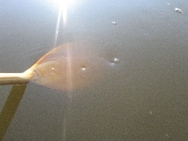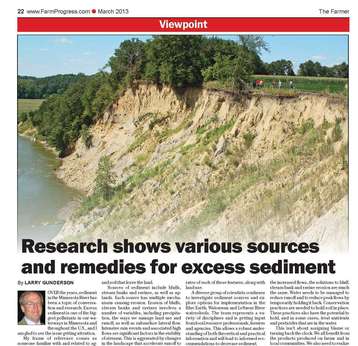|
The Minnesota Pollution Control Agency (MPCA) recently posted the 100-plus comments it received on the draft South Metro Mississippi Maximum Daily Load (TMDL) during the report’s public notice period in 2012.
The comments are available on the South Metro Mississippi TMDL webpage. Because of file sizes and number of comments, the MPCA has organized the comments into the following PDFs, each bookmarked by the party providing comment:
- Agriculture;
- Government units;
- Individuals;
- Minnesota Soybean Growers (separated from the agriculture file because of file size);
- Municipalities (separated from government units because the comments focus on municipal stormwater);
- Non-profit groups; and
- Tribal organization.
Here are a few excerpts from the comments:
 Minnesota Dept. of Natural Resources: “In addition to the site specific standard, we also agree with and support the load allocations and sediment source findings in this TMDL. MnPCA incorporated scientists across diverse fields of study and associations with multiple entities. The science produced has been the backbone to many subsequent Watershed Restoration and Protection studies and provides a solid starting point as natural resource professional’s work on implementing projects that will help bring the river back into compliance and better understand systemic and localized causes of excess sediment.”
- Minnesota Soybean Growers: “The petitioners ask that the MPCA properly determine the natural background levels of the load allocation, as well as determine loads allocations that properly account for the impact of volatile suspended solids on the turbidity measurements. The petitioners also request the load allocations be determined using measurable and distinguishable evidence as is established in the Minnesota Clean Water Legacy Act.”
- Several dozen individuals: “I strongly support the goals established in the Minnesota Pollution Control Agency's Draft South Metro Mississippi River and Minnesota River TSS TMDLs. Achieving these TMDL goals will restore aquatic life and health to these vital water resources. However, the draft TMDLs provide little assurance that these goals will be met. I recommend three fundamental changes to the draft TMDLs as written. 1. Provide Accountability for Farm Operations … 2. Target Conservation Funding for Maximum Impact … 3. Set Milestones and Timelines …”
-
Minnesota Center for Environmental Advocacy: “The draft TMDL fails to provide reasonable assurance that either the load allocation for nonpoint sources or the wasteload allocation for point sources will be achieved such that water quality standards for total suspended solids will be met. Without reasonable assurance, the TMDL cannot be approved by EPA. MCEA recommends that the TMDL be amended to address each of the deficiencies identified above prior to adoption and submittal to USEPA.”
- Minnesota Cities Stormwater Coalition: "This TMDL, through the linkage to the MS4 permits, creates immense new legal obligations and liabilities for regulated MS4 cities. The simplest example of this is the $850 million cost estimate to achieve the MS4 WLA. These obligations and liabilities are not controllable by the MPCA. The MPCA has limited enforcement discretion under the Clean Water Act and State statutes and rules. Independent third parties are encouraged and empowered to act as private attorneys general to sue either the MPCA or the permitted parties to ensure compliance. There is a history of such suits under the TMDL and stormwater permitting programs in Minnesota and the United States. The power to create such significant new legal obligations and liabilities should be exercised with restraint, responsibility, and based on rigorous science, research, modeling, and analysis. These standards have not been met by this TMDL study and report.
-
Mendota Mdewakantan Dakota Community: “We are writing this letter to inform you of a problem that affects Lake Pepin, the Mississippi and Minnesota rivers. As you may know the increases of sediment that is occurring in Lake Pepin is due primarily to the impact from the Minnesota River. Data such as Daniel Engstrom’s study, indicate that the sediment has increased substantially since the early 1940s. The sediment build-up blocks vital sunlight to plant growth and alters the eco-system and has had a direct impact on the wildlife and fisheries of the region. We as a community through the generations has seen the quality of the water and wildlife degrade to its current existing condition. We feel the MPCA along with the help of the Federal government can change this for the good of our community both here in Mendota and also to our neighbors downstream. We believe the sediment increases are due partly to the alterations made to the Minnesota river in the 1940s at Mendota and slightly upstream. The removing of three critical bends in the Minnesota River prior to reaching the Mississippi river has minimized and eliminated the opportunity for the sediment to collect in these last bends of the river. In addition, the changes to the river have had a cultural affect on our community and prevent us from freely accessing our sacred land.”
The MPCA continues to develop its responses to the comments and requests for contested case hearing requests received on the Greater Blue Earth, Minnesota and South Metro Mississippi river TMDLs.
|
 “Since the Dust Bowl years of the 1930s, conservation professionals and farmers have worked together on practices addressing erosion, soil health and sustainability. Because of this partnership, erosion and sediment losses have been reduced significantly. However, sediment continues to be one of the most common pollutants in our waterways,” writes Larry Gunderson, Minnesota River Basin coordinator for the MPCA, in the March 2013 edition of The Farmer.
In the viewpoint, Gunderson, who grew up on a farm near Ada in the Red River Valley, describes recent research into sediment sources and the key role that farmers play in reducing runoff and erosion.
“This isn’t about assigning blame or turning back the clock. We all benefit from the products produced on farms and in local communities. We also need to realize that we can no longer move our water downstream without giving thought to those downstream landowners and ecosystems. Concluding that bank erosion is an unsolvable problem will not help people losing property, local infrastructure or aquatic life in the river,” he writes.
Read the full article, “Research shows various sources and remedies for excess sediment,” on The Farmer website.
|
A new study by a team of researchers at the Science Museum of Minnesota and several major universities, published online March 1, 2013, in the journal Hydrological Processes, has shown that the extensive network of ditches and underground tiling used to enhance agricultural yields has had the unintended consequence of increasing river-channel erosion and sediment loads. The purpose of the three-year study was to determine why stream flow has increased in some agricultural watersheds and not in others, and to determine if these hydrologic changes triggered an increase in erosion of stream channels. After constructing a detailed water budget, the researchers found that artificial drainage could be identified as the major driver of increased river flow, exceeding the effects of precipitation and crop conversion.
For more detailed information on the study, entitled, “Twentieth century agricultural drainage creates more erosive rivers,” see the abstract online.The study was led by Shawn Schottler, senior scientist at the St. Croix Watershed Research Station of the Science Museum of Minnesota, and was co-authored by Jason Ulrich of the University of Minnesota (Dept. of Biosystems and Bioproducts Engineering), Patrick Belmont of the University of Utah (Dept. of Watershed Science), Richard More from Minnesota State University-Mankato (Water Resources Center), J. Wesley Lauer at Seattle University (Dept. of Civil and Environmental Engineering), and Daniel Engstrom and James Almendinger, also from the St. Croix Watershed Research Station.
Over the past six months, the Lake Pepin Legacy Alliance has been developing a Local Resource Management Scorecard to compare conservation efforts across the Minnesota River Basin, which contribute to the reduction of sediment, both in the Minnesota River and in Lake Pepin. Although the Scorecard is still a work in progress, and by design, will require regular updates and changes as new information becomes available, visitors can find much information on the counties that have been uploaded.
For a brief overview of the project, including comments from county commissioners and a guide to using this web tool, watch the video on YouTube.
TMDL project contacts
South Metro Mississippi
Robert Finley
Regional Manager, Watersheds
MPCA
12 Civic Center Drive, Suite 2165
Mankato, MN 56001
robert.finley@state.mn.us
507-344-5247
Minnesota River
Larry Gunderson
Minnesota River Basin Coordinator
MPCA
520 Lafayette Road N
St. Paul, MN 55155-4194
larry.gunderson@state.mn.us
651-757-2400
Greater Blue Earth River
Paul Davis
Project Manager
MPCA
12 Civic Center Plaza, Suite 2165
Mankato, MN 56001
paul.a.davis@state.mn.us
507-344-5246
|